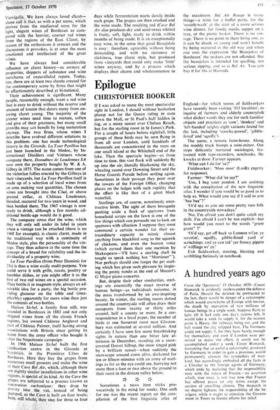The red wines of the Gironde were enjoyed by the
inhabitants of the British Isles even before the marriage of the heiress of Aqui- taine with the about-to-be-Henry II gave the region to the English crown for three cen- turies. The Romans and even possibly the Phoenicians made the first cross-Channel shipments of wine from what was then Vurvigalia. We have always loved claret— alone call it that, as with a pet name, which derives from the mediaeval term for the light, elegant wines of Bordeaux as com- pared with the heavier, coarser red wines from the regions of the East. Claret, by reason of the enthusiasm it arouses and the discussions it provokes, is at once the most emotional and intellectual of the great wines.
We have always had considerable influence on claret history—as owners of properties, shippers of substance and wine merchants of unparalleled repute. Today, too, there are at least two clarets created for the contemporary scene by firms that might be affectionately described at bi-national.
Their achievement is significant. Many people, reasonably enough, want a red wine that is easy to drink without the reserve and amount of tannin that deters many from en- joying claret young. The majority of the greater wines need time to mature, soften and give of their greatness, but many small growths may Hot benefit by long maturation anyway. The two firms whose wines I describe have evolved different solutions to this problem; one has made technological history in the Gironde. La Tour Pavillon has just been launched in the Medoc, by In- ternational Distillers and Vintners whose company there, Domalnes de Loudennes SA now own the property bought by W. & A. Gilbey in 1875. The name comes from one of the victorian follies erected by the Gilbeys in their vineyards, but La Tour Pavillon itself is made up of a selection of local wines from an area making vast quantities. The chosen wines are brought into the Chai, or above ground cellar, at Château Loudennes, blended, matured for two years in wood, and then bottled there. The 1967 vintage is now ready to drink, although a few months ad- ditional bottle-age would do it good.
The company stress that the wine, which they will only sell under its label in years when a vintage can be attached (there is no 1968 for example), is classic claret, made in the traditional way with a continuity of Medoc style, plus the personality of the vin- tage. They thus achieve at the same time the concept of a brand for reliability and the in- dividuality of a property wine.
La Tour Pavillon (from Peter Dominic for 23s) is thus a wine easily multi-purpose. You could serve it with grills, roasts, poultry or humbler dishes, or you might offer it as the first of two red wines on a special occasion. They bottle it in magnum style, always an ad- mirable idea for a party, the big bottle pro- viding glamour on the table and (inex- plicably) apparently far more wine than just the contents of two bottles.
Maison Sichel, a family firm still, was founded in Bordeaux in 1883 and not only shipped wines from all the classic French regions, but owned Château Angluvet and part of Château Palmer, itself having strong associations with Britain since getting its name from the army officer who bought it after the Napoleonic campaign. In 1966 Maison Sichel built the first vinification centre in the Gironde at Verdelais, in the Premieres Cotes de Bordeaux. Here they buy the grapes from numerous small growers and make the wine at their Cave Bel Air, which, although there are slightly similar installations in other wine regions, is special of its kind. At the Cave the grapes are subjected to a process known as maceration carbonique: they drop by gravity into the vat, instead of being Pumped, as the Cave is built on four levels; here, still whole, they stay for three to four
days while fermentation starts slowly inside each grape. The grapes are then crushed and the wine made. The resulting red (Cave Bel Air also produces dry and semi-sweet whites) is fruity, soft, light, ready to drink within months of being made. It is an exceptionally easy wine, in the sense that good Beaujolais is easy : therefore, agreeable without being demanding, and with no sternness or stickiness, true claret style, but produced from vineyards that could only make 'little' wines anyway, and by a process which displays their charm and wholesomeness to the maximum. Bel Air Rouge is many things—a wine for a buffet party, for the 'mouth-wash' at the start of a more serious wine dinner, for family meals, supper on a tray, or the picnic basket. There is no vin- tage. There is no point in there being one, as it can be drunk so young and won't benefit by being matured in the old way and when one uses the expression 'the Beaujolais of Bordeaux' the makers are not offended. But the beaujolais is intended for quaffing, not serious sipping, and so is Rd Air. You can buy it for 16s at Harrods.







































 Previous page
Previous page